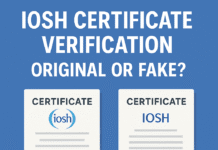
IOSH Safety Manager Requirements: Ensuring Workplace Safety
In today’s dynamic work environment, ensuring the safety of employees has become paramount. Organizations across industries are increasingly recognizing the need for dedicated professionals to manage safety effectively. The Institution of Occupational Safety and Health (IOSH) plays a crucial role in setting standards, and becoming an IOSH safety manager requires fulfilling specific requirements.
I. Introduction
A. Brief explanation of IOSH
The Institution of Occupational Safety and Health (IOSH) is a globally recognized organization committed to promoting health and safety in the workplace. Established with the aim of preventing accidents and injuries, IOSH sets guidelines and standards that organizations follow to create a safe working environment.
B. Importance of safety managers
Safety managers are instrumental in ensuring that organizations comply with safety regulations, mitigate risks, and maintain a healthy work environment. Their role is vital in preventing accidents and protecting both employees and employers from potential liabilities.
C. Overview of IOSH safety manager requirements
Becoming an IOSH safety manager involves meeting certain qualifications, gaining relevant experience, and continuously updating skills to stay abreast of industry changes.
II. Qualifications and Education
A. Educational background
While there is no specific educational requirement, a background in fields like occupational safety, health, or environmental management is advantageous. Many aspiring safety managers pursue degrees in these disciplines.
B. IOSH certification requirements
Attaining IOSH certification is a key step. IOSH offers various certifications, and eligibility criteria may differ. However, a common requirement is completion of the relevant training courses and passing the associated exams.
C. Specialized training
In addition to certification, safety managers often undergo specialized training in areas such as risk assessment, incident investigation, and emergency response.
III. Experience and Skills
A. Relevant work experience
Gaining practical experience in safety-related roles is crucial. Many employers look for candidates with a proven track record in implementing safety programs and managing safety initiatives.
B. Essential skills for safety managers
Apart from formal qualifications, safety managers need specific skills such as strong communication, leadership, and problem-solving abilities. They should be adept at conducting risk assessments and formulating effective safety policies.
C. IOSH competency framework
IOSH provides a competency framework that outlines the skills and knowledge expected from safety professionals. Aligning one’s expertise with this framework enhances credibility.
IV. Responsibilities of an IOSH Safety Manager
A. Ensuring compliance with safety regulations
Safety managers play a pivotal role in ensuring that organizations adhere to local and international safety regulations. This involves regularly reviewing and updating safety policies.
B. Conducting risk assessments
Identifying potential hazards and assessing risks is a crucial aspect of a safety manager’s role. This includes evaluating the workplace, machinery, and processes to minimize the likelihood of accidents.
C. Implementing safety policies
Safety managers are responsible for implementing and enforcing safety policies. This involves communicating guidelines to employees, conducting training sessions, and monitoring compliance.
D. Incident investigation and reporting
When incidents occur, safety managers lead investigations to determine the root causes. They also ensure that accurate reports are submitted to regulatory bodies, fostering transparency and accountability.
V. Advantages of Hiring an IOSH Safety Manager
A. Reduced workplace accidents
Organizations with dedicated safety managers experience fewer workplace accidents, leading to lower injury rates and associated costs.
B. Improved employee morale
A safe working environment boosts employee morale and productivity. Knowing that their well-being is a priority fosters a positive workplace culture.
C. Legal compliance and risk mitigation
Safety managers help organizations navigate complex safety regulations, reducing the risk of legal issues and associated financial penalties.
VI. Challenges Faced by IOSH Safety Managers
A. Balancing safety and productivity
Safety managers often face the challenge of maintaining high safety standards without compromising productivity. Striking the right balance is crucial for organizational success.
B. Keeping up with evolving regulations
The field of occupational safety is dynamic, with regulations constantly evolving. Safety managers must stay informed to ensure compliance.
C. Communicating safety concerns effectively
Effectively communicating safety concerns to all levels of an organization can be challenging. Safety managers need strong communication skills to convey the importance of safety measures.
VII. Career Growth and Opportunities
A. Advancement prospects for safety managers
Experienced safety managers can advance to leadership positions, overseeing safety programs on a broader scale.
B. Networking within the industry
Building a professional network within the safety industry opens up opportunities for collaboration, knowledge sharing, and career advancement.
C. Continuous professional development
Staying competitive in the field requires safety managers to engage in continuous learning. This can involve attending workshops, conferences, and pursuing additional certifications.
VIII. How to Become an IOSH Safety Manager
A. Step-by-step guide to certification
- Research IOSH certifications and choose the most relevant one.
- Enroll in the required training courses.
- Prepare thoroughly for the certification exam.
- Successfully pass the exam to obtain certification.
B. Gaining relevant experience
- Seek entry-level positions in safety-related roles.
- Volunteer for safety projects and initiatives.
- Build a strong portfolio showcasing practical experience.
C. Resources for exam preparation
Utilize study materials provided by IOSH, attend exam preparation courses, and engage with online communities for valuable insights.
To become an IOSH (Institution of Occupational Safety and Health) Safety Manager, individuals typically need to fulfill certain requirements. IOSH is a professional body for health and safety practitioners, and obtaining their certification can enhance your career in occupational safety. Here are the general requirements:- Education and Qualifications:
- A relevant educational background in health and safety, such as a degree or diploma in occupational safety and health, or a related field.
- Some positions may require specific certifications or qualifications in health and safety.
- Experience:
- Practical experience in the field of occupational safety and health is often required. The specific amount of required experience may vary depending on the level of certification.
- IOSH Membership:
- Membership with IOSH is often a prerequisite. There are different levels of membership, such as Affiliate, Associate, and Chartered Member, each with its own set of requirements.
- IOSH Certification:
- Completion of IOSH certification courses, such as the IOSH Managing Safely course, is typically necessary. This course covers essential health and safety topics and provides a foundational understanding of safety management.
- Continuing Professional Development (CPD):
- IOSH Safety Managers are expected to engage in ongoing professional development to stay current with industry trends and best practices. This may involve attending conferences, workshops, or completing additional training.
- Skills and Competencies:
- Demonstrated skills in risk assessment, incident investigation, and the ability to implement effective safety management systems.
- Strong communication and leadership skills to effectively convey safety policies and procedures to employees at all levels.
- Professional Ethics:
- Adherence to high ethical standards and a commitment to promoting a safe and healthy working environment.
- Examination:
- Depending on the specific IOSH level, candidates may need to pass an examination to demonstrate their knowledge and understanding of health and safety principles.
It's important to note that requirements may vary, and it's advisable to check the specific criteria outlined by IOSH for the level of certification you are seeking. Additionally, staying informed about any updates or changes to certification requirements is crucial for maintaining and advancing your career in occupational safety.IX. Conclusion
A. Recap of IOSH safety manager requirements
Meeting IOSH safety manager requirements involves a combination of education, certification, experience, and ongoing professional development.
B. Importance of safety managers in the workplace
Safety managers play a crucial role in creating a safe and healthy workplace, benefiting both employees and employers.
C. Encouragement for aspiring safety professionals
Encourage individuals aspiring to become safety managers, emphasizing the impact they can make in fostering workplace safety.
How To Become IOSH Safety Manager 2024
How To Become IOSH Safety Engineer 2024
How To Become IOSH Safety Officer 2024
IOSH (Institution of Occupational Safety and Health) Courses
X. FAQs
A. What is the role of an IOSH safety manager?
The role involves ensuring compliance with safety regulations, conducting risk assessments, implementing safety policies, and investigating incidents.
B. How can I become IOSH certified?
To become IOSH certified, choose a relevant certification, complete required training, and pass the associated exam.
C. What are the common challenges faced by safety managers?
Common challenges include balancing safety and productivity, keeping up with evolving regulations, and effectively communicating safety concerns.
D. Are there specific industries that demand IOSH safety managers?
Various industries, including construction, manufacturing, and healthcare, demand IOSH safety managers.
E. How often should safety policies be reviewed and updated?
Safety policies should be reviewed and updated regularly, at least annually, to ensure relevance and compliance.
























